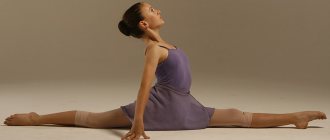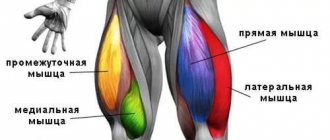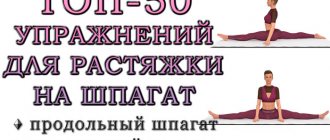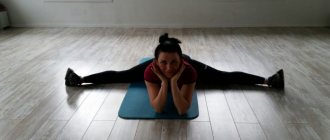© Mikhail Reshetnikov — stock.adobe.com
Share:
Twine is an exercise aimed at stretching muscles and ligaments; it involves spreading your legs in opposite directions, while they form a single line. Good stretching gives the body freedom and relieves stiffness in movement.
Gymnastics distinguishes only two varieties of this figure - longitudinal and transverse. The remaining known subspecies are their variations.
Twine and half twine
The “split” figure has the following characteristics:
- The legs spread apart form a single line.
- When performed correctly, the angle between the legs is 180 degrees.
- The pelvic part is slightly turned forward.
© Vitaly Sova — stock.adobe.com
There is such a thing as half-split. The bent leg takes on the support, and the second leg is moved to the side or back and fully straightened.
© fizkes — stock.adobe.com
Half-split is used as a warm-up before actual stretching.
Transverse and longitudinal
There are two types of twine - longitudinal and transverse. In the first case, one leg is in front of the body and the other is behind, the legs are positioned perpendicular or at an acute angle to the body. It can be left- or right-sided, depending on the leg in front.
© F8studio — stock.adobe.com
With the transverse, the legs are spread apart to an angle of 180 degrees or more. In this case, they are located on the sides, as opposed to longitudinally.
© Nadezhda — stock.adobe.com
Scientists say that cross splits are easier for men than for women. This is due to the structure of the female body; the tone of the adductor muscles prevents quick and painless stretching. On the contrary, it is more difficult for men to perform a longitudinal split. The structural features of the hamstring muscles and their strength seriously impede easy stretching.
In addition, due to the structural features of muscles and joints, 13% of people will never be able to boast of such an ability.
What is twine
Twine refers to an exercise that is aimed at stretching ligaments and muscles. The exercise involves spreading your legs in directly opposite directions. When the split is performed correctly, the legs form a single straight line. Correct execution of the exercise does not cause pain and does not create stiffness in movements. This result is ensured by proper stretching.
Main types
Today, in gymnastics, acrobatic and dance practice, you can find a large number of varieties of splits. Some can be accomplished after just a couple of months of intense training. Other types require complex and daily work.
Transverse
It consists of maximally spreading the legs in opposite directions. Such a split is not given to everyone, even the most flexible people. About 14% of people on earth will not be able to perform this exercise due to the peculiar structure of the pelvis. It has been noted that cross splits are most convenient for men to perform, since women’s hips are much more difficult to perform such exercises.
Longitudinal
An exercise in which the legs are spread forward and backward. The position represents a straight longitudinal line made by the legs. It is more difficult for men to perform this exercise, since they have a much more powerful hamstring, which is difficult to develop and straighten. Longitudinal twine is divided into right-handed and left-handed. Depending on which leg is put forward, the name of the split is given. Transverse and longitudinal twine have their own subspecies, which include certain features, nuances and additional elements.
Classical
The classic split is understood as an acrobatic element, as a result of which the angle formed between the inner surfaces of the thighs is 180 degrees. This is the most common exercise, landing on the floor.
Overweight or negative
Implies that the angle between the legs will be much greater than 180 degrees. The gymnast, standing on the supports, begins to do the splits. It turns out that the feet are slightly higher than the hip part of the body.
Horizontal
It is directed along the horizon line.
Vertical
The exercise is performed while standing, with the right or left leg going up when swinging.
Twine on hands
Performed in a standing position on your hands or resting on your elbows. First, the gymnast takes a vertical position, and only then begins to spread his legs.
Half twine
This is a very effective stretching exercise. Initially, it can only be completed after some time of preparation. Half splits prepare your body well for a full exercise. In order to perform it, you need to get down on the floor. One leg is extended, the other is bent to the maximum level towards the floor. In this position, you need to fix your feet and try to stretch your body towards the outstretched leg.
How long before you can sit down
The question of timing is purely individual. It all depends on age, the number of workouts and their intensity. If a person already has experience in gymnastic procedures, and stretching is done regularly, then he can fully do the splits in just 1-2 months. The main condition is intensive training. If a person has just started stretching, it will take much more time.
It will take three to four months to get into a full split. The conditions for this are daily exercise and a properly selected set of exercises.
After 20 years, a person develops physiological characteristics that can affect both a decrease and an increase in the time required to achieve the goal. Much depends on gender. For example, men have a harder time stretching ligaments and muscles.
Therefore, in order for the average man to do the splits, he will have to spend 5 to 10 months of hard training. Women are much luckier in this regard. Even beginners, exercising regularly three to four times a week, can do the splits after 3 months.
However, before developing an exercise program and moving on to training, you need to understand how realistic this is in your case.
It is possible to do the splits if you do not have a spinal fracture, osteoporosis, osteochondrosis and other chronic diseases associated with blood vessels and the functioning of the circulatory system. It is better to discuss the possibility of such physical activity with your doctor.
Possible variations
There are a large number of variations of the two forms of twine. There are seven subtypes of this gymnastic element.
Classical
It is the raising of the legs to a position in which the angle between the inner surfaces of the thighs is 180 degrees, in accordance with the above characteristics.
Performed on a flat surface or floor:
© khosrork — stock.adobe.com
Negative (sagging)
One of the most difficult types of twine. To perform it, you will have to acquire additional equipment, for example, chairs or a wall bars.
The main characteristic of this type is the angle between the thighs, which exceeds 180 degrees.
Performing this exercise requires high concentration and good muscle tone, as well as constant self-improvement. It is not available to everyone.
© zhagunov_a — stock.adobe.com
Horizontal
It consists of spreading your legs along the horizon line. It is a classic twine, usually performed on the floor. Hands are usually held straight in front of you or spread to the sides.
© Sergey Khamidulin — stock.adobe.com
Vertical
It differs from the previous one in the position of the legs in space - in this case they are located perpendicular to the horizon. While standing, a person leans on one of his legs and lifts the other into the air. A pylon or wall bars are often used as a support.
Vertical longitudinal twine:
© Prostock-studio — stock.adobe.com
Transverse modification must be done with hand support:
On hands
For this option, the athlete must have unique skills in balance and control of his own body. Standing in a handstand, the person slowly spreads his legs to the sides:
© fizkes — stock.adobe.com
Option with longitudinal twine on hands:
© master1305 — stock.adobe.com
Another variation is forearm stand:
© sheikoevgeniya — stock.adobe.com
Air
It is done in the air, most often in a jump, but some people know how to perform this element while standing still. By jumping and swinging his legs, a person achieves the desired turning angle in the air.
It is noteworthy that not all aerial twine masters can perform the classic one.
© Andrey Burmakin — stock.adobe.com
Lying on the floor
The main condition is to rest your back on a flat surface. From the starting position lying on the floor, a person spreads his legs to the sides, getting a transverse split:
© sonsedskaya — stock.adobe.com
To perform the longitudinal one, one leg is placed on the floor and the other is pulled towards the head, supported by hands:
© Artranq — stock.adobe.com
Half twine
Half twine is often considered a separate type. However, there is still debate among experts whether it should be considered a separate acrobatic element or a full-fledged type of twine. To perform it, you need to sit on the floor, take one leg back, and bend the other and bring it as close to the groin as possible. Doing the half-split is almost painless, which is why it is often recommended for beginners.
Precautionary measures
During stretching exercises, you need to be extremely careful - especially when someone around you is trying to “help”. After all, no one except the person himself can know about the condition of his muscles. All exercises for mastering the splits, as well as developing turnout, must be completed strictly under the supervision of a professional trainer. Acrobatic elements should be performed only after warming up and the body is warmed up. Otherwise there is a high risk of injury. It is also worth remembering relaxation - the main aspect of stretching. In order to do the splits, you need to constantly perform painful exercises. The body resists the unpleasant sensations, the muscles tense. Doing the splits becomes more difficult and the risk of injury increases. To prevent them, you should always ensure that the muscles are as relaxed as possible.
Royal twine
The royal split is considered the pinnacle of excellence in gymnastics. The famous actor Jean-Claude Van Damme demonstrated this element in a commercial for the Volvo automobile company.
The main difference between this type is the use of supports for two feet. At the same time, the body remains suspended. To perform an element, not only absolute flexibility, strength and elasticity of ligaments and muscles are required, but also statistical muscle strength.
Daily training, the ability to control your own body, as well as yogi breathing will help you perform the royal split. The breathing trick of inhaling and exhaling through the larynx effectively warms up the body.
© marinafrost — stock.adobe.com
How do the splits?
Daily or regular stretching exercises, especially for women, will bring a huge benefit to the body.
The benefits of such exercises have long been proven:
- support muscle tone;
- improvement of joint mobility;
- acceleration of blood flow in the pelvic organs;
- increasing muscle elasticity.
Exercising will help strengthen your body and reduce the risk of sprains and injuries.
Experts say that with age, muscle elasticity decreases and doing the splits after 30 or 40 years is much more difficult than in childhood or adolescence. To a greater extent, this axiom is true, but this does not mean that doing the splits after 40 is impossible. Persistence and regular training will help you achieve your desired goal.
The timing of stretching and performing the gymnastic element in question is quite difficult to determine. It all depends on the individual characteristics of the body and a number of reasons:
- stretching abilities;
- age category;
- joint flexibility;
- frequency of training and its conditions.
With regular and diligent exercise, a person can stretch out quite quickly, but this is unlikely to happen in a week or even a month. Provided, of course, that he had never stretched before. A couple of months for people under the age of 45 seems to be a realistic period with the right and well-chosen exercises.
Just trying to do the splits every day is not the most competent thing; it is better to approach it gradually, starting with warm-up and preparatory exercises. When the stretching improves, you can try to perform the figure.
An incorrect preparation program for performing the splits can cause irreparable harm to the body and spoil elasticity.
Rules for proper stretching:
- exercise regularly (the exercises will not take more than 15 minutes, so you should do them daily or every other day);
- exercise in a warm room (the air temperature in the room should be at least 20°C; in a cold room, muscles become less elastic, which can lead to injury);
- be careful (do not rush; during fast activities there is a high risk of injury, for example, sprains);
- Don’t rush and work too hard trying to achieve quick results, this can lead to serious injuries.
It is best if a person also finds associates who are moving towards a similar goal.
Watch some useful videos on learning to do the splits:
Recommendations
- To master one of the splits, it is necessary to carry out a good warm-up, otherwise even the simplest element can cause serious injuries. Read more about warming up before the splits →
- Remember that for beginners, especially those over the age of 11, developing the splits becomes more difficult every year. Therefore, training should be gentle and under the supervision of experienced trainers.
- Do not immediately strive for slack twine if you have not yet mastered the simplest options.
- Do not ask an assistant to put pressure on you, do not use various weights for stretching.











